Psoriasis refers to skin diseases and obviously an unpleasant rash on the body. They almost did not suffer, but very itchy and looks ugly, so it gives a person a lot of inconvenience. A look at what are the different types of psoriasis, how they differ and how you can cure the disease .
Classification of psoriasis according to ICD-10
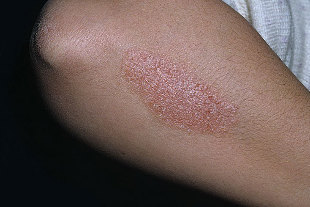
According to the international classification of diseases psoriasis L40 is the code. This means that it refers to papuloscentus violations (from lat. purple papules - "node" and squama "scale").
L40.0 Psoriasis vulgaris
Other names: plaque-like. Diagnosed almost 90% of cases. Occurs pimples the scaly structure. Plaque can be gray, silver-white or reddish color. Papules sometimes grow, to connect with neighbouring countries and constitute the entire "Islands" or "lakes".
L40.1 generalized pustular Psoriasis
Other names: pericardial, impetigo, disease Tsumbush. Considered to be the most difficult, manifested by vesicles or blisters filled with inflammatory substances, exudate. If the bottle is opened and inside you get an infection, psoriasis becomes purulent. Most of these occur in the blisters on the hands and feet, sometimes on the body.
L40.2 Acrodermatitis, persistent
Other names: Crocker rash, rash Setton. Content of the pustules (pustules), when the form of psoriasis, is sterile, so acrodermatitis is not a contagious disease. The main disadvantage is that plaque can form on your fingers, which can flake off the nails.
L40.3 Blisters on the palms and soles
Other names: pustular bacterial poison. The title is clear that this type of psoriasis affects the soles and palms. They are covered with large and small pustular formations, which gradually grow and increase in size. Contents of the pustules are sterile, but pustular bacteria is considered a serious disease. Treatment is complicated by the fact that the pustules are constantly exposed to mechanical stress (wear and is opened when walking).
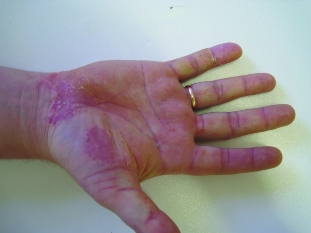
L40.4 guttate Psoriasis
Occurs as small purple dots, scattered over the thighs, legs, arms , shoulders, head, neck and back. Frequently develops after experiencing a sore throat or pharyngitis .
L40.5-7 arthropathic Psoriasis
Other names: psoriatic joint disease, psoriatic arthritis. The disease affects about 10% of all patients with psoriasis. Affect the joints and connective tissue . Outwardly manifested in the swelling of the phalanges of the hands and feet. Less frequently affects the hip, humeroscapularis joints, knee joints and spine. Sometimes lead to disability: the patient can move.
L40.8 Other psoriasis
Other names: inverse psoriasis. Looks smooth inflamed patches that almost no flakes and localized to the skin folds and the folds (groin, elbows, genitals, under the breasts, etc.). Difficulties treatment other psoriasis is associated with the constant friction of the affected regions, as well as sweat in the skin folds. Often inverse psoriasis cause a fungal infection.
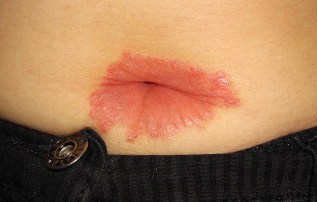
L40.9 Psoriasis unspecified
This includes all the other forms of psoriasis that do not fit into any of the above.
There is another divide in psoriasis category of clinical classification.
Localization
Psoriatic plaques can spread to different parts of the body.
- The palms and soles. As already explained earlier, this pustular bacteria (the code L40.3).
- Joints . About psoriatic arthritis also talked about (the code L40.5-7).
- The mucous membranes of the. Eruptions appear in the oral mucosa, conjunctiva and mucous membranes of the genitals. Education in the form of inflammatory elements in different forms, but with clear boundaries. About - a small swelling.
- Nails . Scientific name: psoriatic onychodystrophy. Symptoms: depressions and grooves on the surface of the nail, the dullness of the nail plate, peeling, chipping, bleed through the capillaries, the itching near the cuticle.
- Scalp. This type is called seborrheic psoriasis. Many people confuse it with dandruff , because one of the symptoms is the flaking of the scalp. But the seborrheic psoriasis is a lot more unpleasant disease, because the skin crack area to the ears and may extend to the neck. All this is accompanied by severe itching and bruising, while tearing off a scab .
- Large folds of skin or intertrigio psoriasis. A flat is formed in between the fingers, in the groin, armpits and under the Breasts in women.
- The surface of the body. This phenomenon is called erythroderma. A variant of this disease is a large part of the die, because of their plaques, the skin loses its basic functions: temperature control, barriers, etc.
- Systemic failure is also dangerous, because it involves a combination of several types of psoriasis.
The clinical picture
The manifestations of psoriasis are:
- ordinary (vulgar);
- exudative;
- pustular;
- arthropathic;
- in the form of erythroderma.
Psoriatic erythroderma
All the typology above.
The development stage
If you consider psoriasis from the perspective of its staging , it is possible to allocate some stages.
Progressive psoriasis
The stage of maturation of the inflammation. Has the following features:
- training pink smooth papules;
- itching;
- the inflammatory reaction when irritation, pimples (scratching, trying to pierce with a needle or toothpick, etc.);
- start peeling the individual sections.
Inpatient psoriasis
Stage proceeds almost without any changes:
- new pimples will not form;
- old platelets do not increase in size;
- peeling medium.
The recession of psoriasis
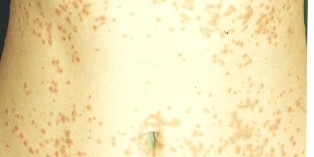
In the last stage, when the wounds are overgrown. Healing starts in the middle. The former site of the plaques formed a white depigmented spot that does not cause discomfort, in addition to the aesthetic component.
Seasons of aggravation
Psoriasis is characterized by seasonal recurrence. In this regard, distinguish:
- in the summer psoriasis: worsen under the action of sunlight;
- winter psoriasis develops due to the intense cold. by acting on the skin;
- the off-season for psoriasis: the most severe form of which without remission periods. So the disease occurs throughout the year.
It seems that the symptoms of psoriasis unified
The area affected skin
In this classification only 2 types of psoriasis:
- limited - less than 20% of the skin of the body;
- common - more than 20%;
- universal - struck the entire skin.
The classification of the National science Foundation (USA)
Psoriasis varies and the area affected:
- easy: lose up to 2 % of the surface area of the skin;
- moderate: 2-10%;
- heavy: more than 10%.
International PASI
The table index calculation damage psoriasis
PASI represents the numbers 0 72 and indicates the severity of the course of psoriasis the most mild clinical signs ( redness and peeling of the skin) or severe (bruising, suppuration). The index is determined by the experts.
Treatment of psoriasis
Modern strategy of treatment of the disease involves the use of a variety of methods. It is important to adhere to three main objectives:
- to achieve rapid initial positive results;
- follow the ineffectiveness of some methods and override them, but continue to use what helps;
- bring the patient to remission.
Among the various types of psoriasis treatment is two:
- drug-free;
- medication.
Non-drug treatment
If it is possible to do without medication, doctors always try to use it. Treatment of psoriasis significant role can be played by multiple factors, non-pharmacological treatment.The mode of the day
People who suffer from psoriasis is:
- trying to quit Smoking;
- avoid alcohol (beer);
- wear the clothes and bedding of natural materials;
- change detergent soap ;
- short cut nails;
- wash only in the shower, not to visit the bath and sauna;
- try to remove the stress.
Diet for psoriasis
Positive dynamics in the treatment of psoriasis has a good effect on low-protein diet, restricting protein is 30 grams per day. The results show good patients who times a week to do the dismantling. On this day you can eat 2-3 tomatoes, a few leaves of lettuce, 1 cucumber, 2-3 cups of green tea and 300 ml of unsweetened mineral waters.
General principles of diet for psoriasis means:
- freshly squeezed citrus juices;
- fresh or steamed vegetables;
- fresh fish;
- flour only rye flour;
- dried fruits, fruits;
- nuts (not more than 50 g per day).
You should also limit or eliminate: meat, grains, meat, sugar, potatoes, cheese, beans, oils, sweets, coffee.
Spa treatment
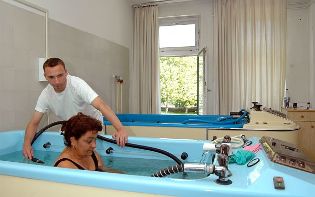
Spa-the treatment is withdrawn, is not the last place in the treatment of psoriasis. This is a great anti-factor.
Psoriasis treatment is the Dead sea .The main advantage of bath treatments: the force of nature in the fight against the disease. Water treatment, balanced nutrition, clean air and soft sun - all this will help to reduce the symptoms of psoriasis go into remission.
A kind of bath treatments with varicose veins is a treatment with Garra rufa fish . These creatures don't have teeth, but the lips they gently eat the particles of scaly skin and improve the microcirculation of the external skin. In addition, the procedure gives a great relaxing effect.
Physiotherapy
Among the physiotherapeutic methods to combat psoriasis skin use the following:
- uv-irradiation;
- range of light therapy ;
- laser treatment ;
- radiotherapy;
- cryotherapy (treatment with cold);
- electrosleep;
- phonophoresis .
With the help of physiotherapy, you can achieve good aesthetic results, because almost all methods include a variety of effects on the skin outside. Plaques are reduced, the formation of healthy skin cells.
Photochemotherapy
This method is highlighted because it is one of the most effective treatment for psoriasis. It is used even in the most severe forms of the disease who do not respond well to other physiotherapeutic procedures. Photochemotherapy is exposure of the skin to long-wave UVA rays. Therefore, another name of the method - PUVA therapy (PUVA) .
Medication
Psoriasis treatment medication also helps to relieve the main symptoms and guide the patient's recovery. It is possible to allocate three stages of the General (systemic) drug treatment of psoriasis:
- The urgent care. Performed in the acute period of the disease and is designed to relieve acute symptoms. Drugs used steroids and sometimes immunosuppressants .
- Transition. Associated with the gradual introduction of weak drugs that have the future to be taken according to the patient courses.
- The current maintenance treatment.
Drug therapy includes the application of topical treatments:
- creams;
- foam;
- gel;
- creams;
- ointments;
- sprays.
Hormonal-based ointment hydrocortisone used for psoriasis
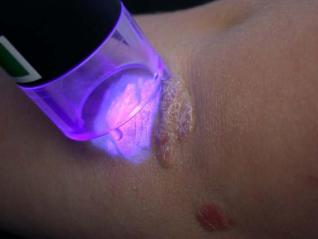
Medicines can be purchased or made according to the recipes of traditional medicine. The funds can stay in the open air, or under airtight dressings. The greatest effect in the treatment of psoriasis is a combination of drug and non-drug therapy. All means and methods, selected doctor.
Conclusion
As you can see, the forms and types of psoriasis very much, and find out what kind of disease exactly you have, is very difficult. Therefore, the appearance of primary symptoms should consult a doctor who will determine the type of psoriasis and prescribe appropriate treatment. The earlier you start to deal with psoriasis, more effective and quick results.
























